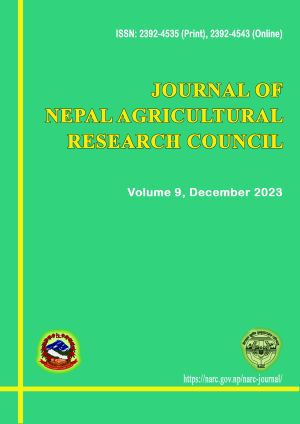Performance Evaluation of Khari and Boer Crossbred Goats in Mid Hills Under Optimum Management Regime.
DOI:
https://doi.org/10.3126/jnarc.v9i1.61606Keywords:
Genetic group, breed, parity, season, weightAbstract
Goats are recognized as a vital and versatile livestock commodity with significant importance in rural farmers’ communities of developing countries, including Nepal. Growth, reproductive and litter performances are considered as the major economic traits of goats. This study was designed to compare the growth, reproduction and litter traits of goat kids and does at mid hill region for different non-genetic factors such as genetic groups (Khari, Boer 75% and 50%), parity (early, mid and late), season of conception and kidding (summer, autumn, winter, spring), sex (male and female) and type of birth (single, twins and triplet) under optimum management regime. Data for the four-year study period (2017 to 2021) on production performance were entered into MS-Excel sheet from the data record book of the National Goat Research Program, Bandipur and analyzed by using Mixed Model Least-square and Maximum Likelihood Computer Program PC-2 statistical package. The means were compared using Duncans' Multiple Range Test (DMRT). Results revealed that the effect of genetic group, parity, type of birth and sex were significant (p<0.05) with respect to growth at different stages along with genetic group and parity that were significant with major non-genetic factors affecting reproduction and litter traits. Better reproduction parameters were recorded for the Khari goat breed than Boer crossbred. Similarly, litter traits at both birth and weaning were found better in later parities with better performance in Khari. Males were born heavier and consistent throughout the study period up to eighteen months. Hence, based on the findings of this study, it can be concluded that Khari goat breed has high potential for its reproduction and litter traits with a massive scope of improvement through selection within the population. Likewise, it is also important to consider the growth of inferior Khari goats can also be genetically improved through upgrading up to 75% blood level using an appropriate breed, such as Boer.
Downloads
Downloads
Published
How to Cite
Issue
Section
License
Copyright (c) 2023 Nepal Agricultural Research Council

This work is licensed under a Creative Commons Attribution-NonCommercial 4.0 International License.
This license enables reusers to distribute, remix, adapt, and build upon the material in any medium or format for noncommercial purposes only, and only so long as attribution is given to the creator.

